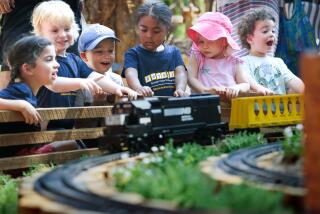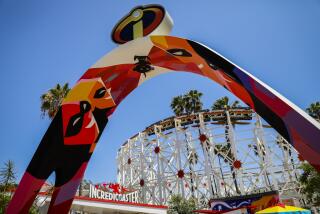Flying Turns roller coaster: Will we ever get to ride this replica of a relic?
Reporting from Knoebels in Elysburg, Pa.--
Over the last five summers, the most anticipated roller coaster hasn’t been a towering, looping speed demon but rather a slow, squat and serpentine 1930s-era replica that disappeared from the amusement park landscape nearly four decades ago.
Since the autumn of 2005, Flying Turns at Knoebels in tiny Elysburg, Pa., has been the all-consuming passion and obsession of theme park President Dick Knoebel and ride designer John Fetterman.
But despite a Herculean effort by the ride’s twin champions, coaster enthusiasts know one hard truth: They may never get to ride Flying Turns.
Photos: Flying Turns toboggan coaster at Knoebels
Traditionally, the trackless Flying Turns features a wooden chute where a coaster train glides freely like an Olympic bobsled through a twisting course at a top speed of 25 mph. But repeated setbacks in re-creating a $3-million replica of the ride have sent the Knoebels team back to the drawing board numerous times.
The challenge of building a one-of-a-kind, modern-day version of a classic ride is just that: There’s no working version to compare it to. Only old plans, grainy photographs and the recollections of a few Flying Turns veterans.
“We knew when we took this project on that there would be serious challenges along the way,” said Knoebel, a determined former U.S. Marine.
Designed by World War I aviator John Bartlett and John A. Miller, known as the “Thomas Edison of Roller Coasters,” the first Flying Turns bobsled coaster was built at Lakeside Park in Dayton, Ohio, in 1929.
Despite the Great Depression, Bartlett and Miller built a total of eight Flying Turns-style rides, with the best-known version at Euclid Beach in Cleveland. The last one standing, the Bobsled at New York’s Coney Island, was demolished in 1974, according to Roller Coaster Database.
During my visit to Knoebels, I took a guided tour of the Flying Turns track, starting at the top and working my way down the twisting and turning track.
Lined with thin strips of tongue-and-groove cypress wood, the trough track looked like the inside of a 50-foot-tall cello neck. The wood, exposed to constant sunlight, looked like a weather-beaten boat deck while the shaded spiral sections sparkled like a hardwood basketball court.
At the base of the toboggan coaster, crews were working on a catch designed to wrangle the careening trains into the braking run.
A series of connected coaster chassissis sans seats stood in the station after undergoing successful test runs. The latest sticking point: the train couplings.
Opened in 1926, Knoebels is probably the only place on Earth where the extinct Flying Turns could rise again. The quirky, traditional, family-run park, which still offers free admission and free parking, retains a passion for resurrecting and rescuing old rides.
In 1985, under Fetterman’s direction, Knoebels saved the 1948 Rocket wooden coaster at Playland Park in San Antonio from the wrecking ball. The relocated ride was aptly renamed the Phoenix.
In 1999, Fetterman designed the Philadelphia Toboggan Co.-built Twister wooden coaster at Knoebels, based on 1964 plans by renowned ride builder John Allen for Mr. Twister at Elitch Gardens in Denver.
Another John Allen creation, the Golden Nugget indoor steel coaster at Morey’s Piers in Wildwood, N.J., was recently relocated to Knoebels and transformed into the three-story Black Diamond dark ride and roller coaster.
Fetterman started at Knoebels in the 1960s as a ride manager, operating and nurturing the temperamental Jet Star steel coaster. He met his wife at Knoebels, and all their kids have worked at the park, with family dinners often taking place in the long shadows of the tall coasters. Fetterman’s son, John Allen, was named after the coaster designer.
Fetterman remembers first seeing old photos of Flying Turns during his early years at Knoebels, marveling at the unfettered bobsleds wildly caroming through the cypress chutes.
In 2003, Fetterman made a bold pitch to the Knoebel family: Let’s build Flying Turns.
It wasn’t a hard sell. Knoebel, who had ridden the old Euclid Beach coaster during the summer of 1961, called it the “most thrilling ride” he’d ever been on.
“I knew what a thrill ride it was,” he said. “We figured we had the know-how to do it.”
Fetterman immediately set about designing a new version of the old ride.
“It’s the culmination of a dream,” Fetterman told the Washington Post in 2006.
Based on the Flying Turns model at Chicago’s Riverview Park, the 47-foot-tall Knoebels’ version will have three lift hills, a 540-degree helix and a signature double figure-eight trough. The 1,300-foot-long half-pipe track will feature a durable and forgiving hardwood surface made of cypress.
Coaster fans salivated when Knoebels first announced plans to build Flying Turns during an October 2005 event. American Coaster Enthusiasts called it one of the most anticipated rides among its 7,000 members.
Construction began in April 2006, with plans for a 2007 debut. By October 2007, following successful test runs, Knoebels felt confident enough to give coaster enthusiasts a tour of the twisting track.
Then trouble started.
“The design of the vehicle was the problem,” Knoebel said. “We essentially had to start from scratch.”
First there were problems with the wheels, which had to be shipped back to the California manufacturer to be corrected.
Another test in summer 2008 found the cars simply too fast and wild to carry passengers. A year later, sections of the track were being redesigned and modified to accommodate new trains. A prototype of the new train proved so encouraging that Knoebels ordered three more. Then during testing in April of this year, the new cars jackknifed during one run.
“They worked beautifully five out of six times,” Knoebel told the local Daily Item newspaper after the failed tests. “It has to be right each time.”
The main challenge has been updating a 1930s ride to modern standards that would meet with approval from state ride inspectors and the park’s insurance carriers. The hardest part has been designing a train with the perfect combination of size, weight, length, height and appearance.
“If we could build vehicles like they did in the 1930s, it would be open,” Knoebel said. “But they’ve changed the rules.”
The third and latest prototype chassis is undergoing on-track testing, with encouraging results.
The planned debut, promised every summer since 2007, remains indefinitely on hold at Knoebels.
More to Read
Sign up for The Wild
We’ll help you find the best places to hike, bike and run, as well as the perfect silent spots for meditation and yoga.
You may occasionally receive promotional content from the Los Angeles Times.







